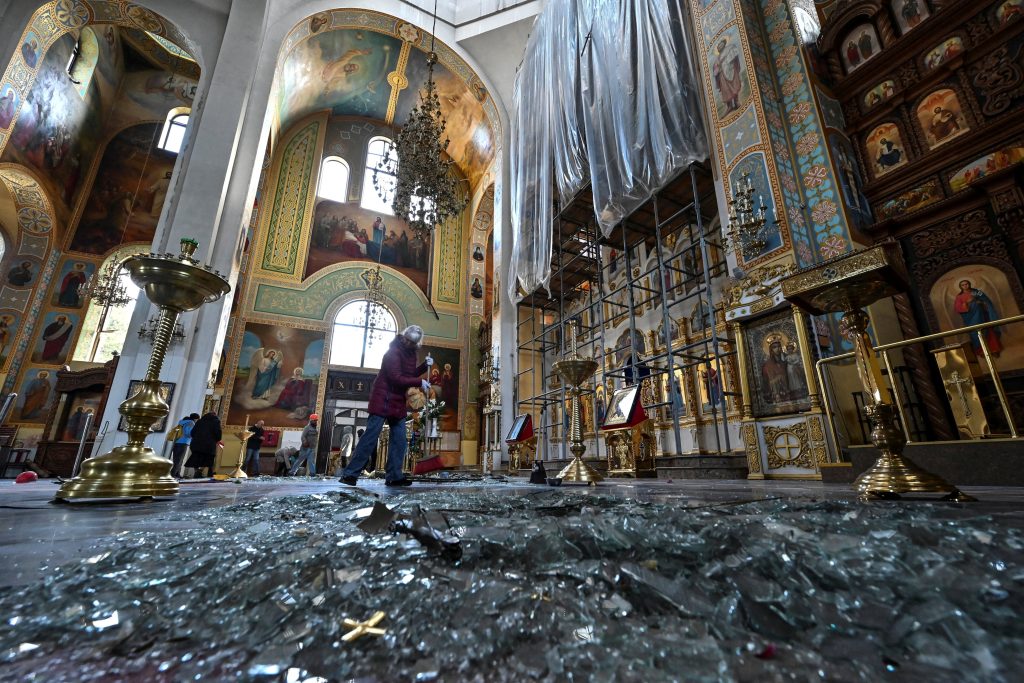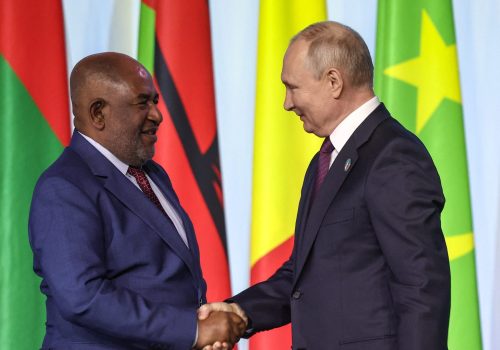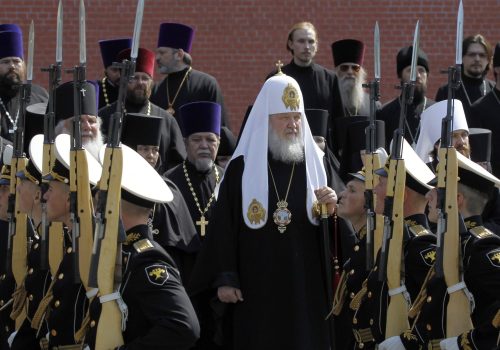Russia’s full-scale invasion of Ukraine has included what many see as a systematic campaign to destroy Ukraine’s cultural heritage. In response to these efforts, a dedicated unit of Ukraine’s Territorial Defense Forces has been formed to carry out the specific task of investigating the targeting of cultural heritage sites across Ukraine. Led by lawyer Vitaliy Tytych, this unit has begun the Herculean task of documenting destruction not witnessed in Europe since the days of Hitler and Stalin.
Stay updated
As the world watches the Russian invasion of Ukraine unfold, UkraineAlert delivers the best Atlantic Council expert insight and analysis on Ukraine twice a week directly to your inbox.
Ukraine’s heritage protection unit carries echoes of the World War II era “Monuments Men” and the US Army’s 2019 creation of a Cultural Heritage Task Force charged with ensuring the US military is equipped to preserve local heritage sites. However, there are key differences: Ukraine’s new Territorial Defense Forces unit is not only working to protect the physical cornerstones of Ukraine’s national identity, but to collect an expanding body of evidence for future prosecutions.
Since the full-scale invasion began on February 24, 2022, Russia has been accused of committing countless war crimes in Ukraine. Targeted attacks on Ukraine’s cultural heritage are seen as part of a broader strategy to eradicate all traces of Ukrainian national identity, which Russia regards as an existential threat to its own imperial identity. Some Ukrainian cultural leaders have defined the Russian invasion as “a heritage war.” Ihor Poshyvailo, the director of Kyiv’s Maidan Museum who currently serves in the Ukrainian military’s cultural heritage protection unit, has described Russia’s invasion as a war “against our historical memory. Against our soul.”
By mid-November 2023, UNESCO had verified damage to 329 cultural sites in Ukraine since the start of Russia’s full-scale invasion. This includes damage to 125 religious sites, 143 buildings of historical and artistic importance, 28 museums, 19 monuments, 13 libraries, and one archive. From Odesa’s National Art Museum to Kherson’s regional library, and from Kharkiv’s Drobytskyi Holocaust Memorial and Memorial to Victims of Totalitarianism to Zaporizhzhia’s Popov Manor House museum, Russia has shelled, bombed, and looted Ukraine’s cultural heritage extensively across the country.
The Russian military’s campaign to erase Ukrainian national identity is sparking strong resistance and a determination to hold Russia internationally accountable. The recently formed Territorial Defense Forces unit is working alongside a growing network of cultural industry experts committed to cataloging Russian crimes.
Ukrainian museum experts have set up the Heritage Emergency Response Initiative (HERI) to document Russia’s attacks while working in coordination with UNESCO. HERI works to collect resources to support museums across Ukraine, responding to regularly updated requests from different regions of the country. Some museum staff have been painstakingly evacuating their collections and storing them to protect priceless works of art from Russian aggression, while others have stayed behind despite obvious dangers to help safeguard Ukraine’s cultural heritage.
Eurasia Center events

Ukraine’s cultural guardians are also receiving international support. One year after the start of Russia’s full-scale invasion, the US Department of State announced that it would invest $7 million to support Ukraine’s cultural heritage protection efforts. In addition, the US Army’s Civil Affairs and Psychological Operation Command has joined forces with the Smithsonian Cultural Rescue Initiative to train Ukrainian soldiers in protecting cultural heritage during armed conflict.
The Smithsonian Institution has also partnered with the Kosciuszko Foundation to provide museums with the necessary tools and technology to safely store priceless works of art. Across the Ukrainian border in neighboring Poland, the Polish Ministry of Culture and National Heritage has established a Cultural Assistance Center to help coordinate domestic and foreign actions to protect Ukraine’s cultural resources.
In a March 2023 study commissioned and published by the European Parliament, researchers determined that the protection of cultural heritage in armed conflict is covered by international humanitarian law, human rights law, cultural law, and criminal law. A report for the European Union Advisory Mission Ukraine found concrete evidence that cultural property has been intentionally targeted during the Russian invasion of Ukraine.
Russia’s war in Ukraine is being fought along many different fronts. This includes the targeting of cultural heritage as Russia attempts to erase Ukraine’s national identity and impose an imperial identity on a conquered nation. The creation of a dedicated Territorial Defense Forces unit reflects Ukraine’s determination to expose this genocidal agenda. By documenting the deliberate destruction of their country’s cultural heritage, Ukrainians aim to raise international awareness of the criminal objectives underpinning Russia’s invasion. Ultimately, the aim is to hold Russia accountable for its crimes.
Mercedes Sapuppo is a program assistant at the Atlantic Council’s Eurasia Center.
Further reading
The views expressed in UkraineAlert are solely those of the authors and do not necessarily reflect the views of the Atlantic Council, its staff, or its supporters.

The Eurasia Center’s mission is to enhance transatlantic cooperation in promoting stability, democratic values and prosperity in Eurasia, from Eastern Europe and Turkey in the West to the Caucasus, Russia and Central Asia in the East.
Follow us on social media
and support our work
Image: A woman removes debris inside a cathedral damaged by a Russian missile strike, amid Russia's attack on Ukraine, in Zaporizhzhia, Ukraine October 18, 2023. REUTERS/Stringer




